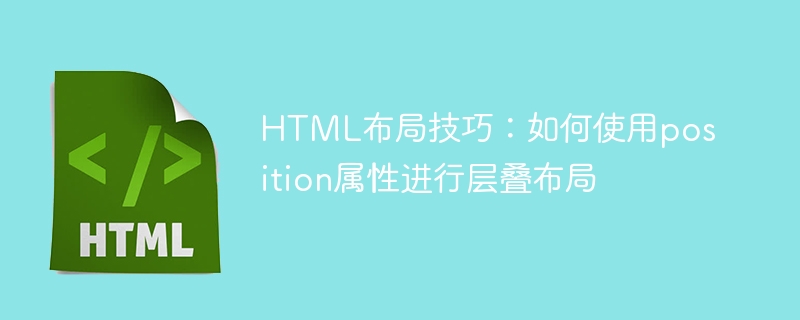Home >Web Front-end >HTML Tutorial >HTML layout tips: How to use the position attribute for cascading layout
HTML layout tips: How to use the position attribute for cascading layout
- WBOYWBOYWBOYWBOYWBOYWBOYWBOYWBOYWBOYWBOYWBOYWBOYWBOriginal
- 2023-10-18 08:03:32808browse

HTML layout skills: How to use the position attribute for cascading layout
In web design, layout is a very important task. Among them, cascading layout is a common and practical layout method. By using the position attribute, we can achieve precise positioning and overlapping effects of elements. This article will introduce the four values of position and their application scenarios, and provide specific code examples.
- Value of position
(1) static: Default value, elements are laid out according to their order in the HTML document, and are not affected by other position attributes .
(2) relative: Relative positioning, the elements will be laid out in the order of the document flow, but the position of the elements can be fine-tuned by setting the top, right, bottom and left attributes.
(3) absolute: Absolute positioning, the element will be separated from the document flow and positioned relative to its nearest non-statically positioned parent element. If there is no non-statically positioned parent element, it is positioned relative to the body.
(4) fixed: fixed positioning, the element is positioned relative to the browser window, and the element position will not change no matter how the page is scrolled.
- Application of relative positioning
Relative positioning is often used to fine-tune the position of elements. The following is an application scenario: adding a mask layer to an image.
HTML code:
<div class="container"> <img src="/static/imghwm/default1.png" data-src="image.jpg" class="lazy" alt="图片"> <div class="overlay"></div> </div>
CSS code:
.container {
position: relative;
width: 500px;
height: 300px;
}
.overlay {
position: absolute;
top: 0;
left: 0;
width: 100%;
height: 100%;
background-color: rgba(0, 0, 0, 0.5);
}In the above code, the .container element is set to relative positioning, .overlay The element is set to absolute positioning, and is filled with the .container element through the top, left, width and height attributes. By setting background-color to translucent black, a translucent mask layer is added to the image.
- Application of absolute positioning
Absolute positioning is often used to create floating effects or implement cascading layouts. The following is an application scenario: Create a drop-down menu in the navigation bar.
HTML code:
<div class="navbar">
<ul>
<li><a href="#">首页</a></li>
<li class="dropdown">
<a href="#">产品</a>
<div class="dropdown-content">
<a href="#">产品1</a>
<a href="#">产品2</a>
<a href="#">产品3</a>
</div>
</li>
<li><a href="#">关于我们</a></li>
</ul>
</div>CSS code:
.navbar {
position: relative;
background-color: #f1f1f1;
height: 50px;
}
.dropdown {
position: relative;
display: inline-block;
}
.dropdown-content {
position: absolute;
top: 100%;
left: 0;
display: none;
background-color: #ffffff;
box-shadow: 0 2px 5px rgba(0, 0, 0, 0.3);
}
.dropdown:hover .dropdown-content {
display: block;
}In the above code, the .navbar element is set to relative positioning, .dropdown The element has relative positioning set, and a .dropdown-content element is created inside it, with absolute positioning set. By setting top: 100% and left: 0, the .dropdown-content element is positioned below the .dropdown element, and by setting display: none, the drop-down is not displayed in the initial state. menu. By setting .dropdown:hover .dropdown-content { display: block; }, a drop-down menu is displayed when the mouse is hovering over the .dropdown element.
Summary:
By using the position attribute, we can realize the cascading layout of elements and achieve various special effects. This article introduces the four values of position and its application scenarios, and provides specific code examples. I hope readers can learn how to use the position attribute through this article, and can use it flexibly in actual projects to achieve rich and diverse web page layout effects.
The above is the detailed content of HTML layout tips: How to use the position attribute for cascading layout. For more information, please follow other related articles on the PHP Chinese website!

